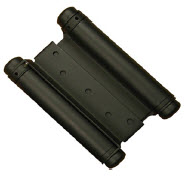
Double-action spring door hinges are commonly used in workplaces, businesses and public facilities. They allow for an omnidirectional swinging action. Doors installed with double-action spring door hinges will swing in both ways. For a better understanding of double-action spring door hinges and how they work, keep reading.
Spring Door Hinges Explained
Spring door hinges are spring-loaded mechanical bearings that are designed for use with a door. They allow for a limited angle of rotation, meaning you can pull or rotate the door open.
The enclosed spring will automatically close the door. As you open the door, the enclosed spring will stretch to create tension. The spring door hinge will then use this tension to pull the door back to its original, closed position.
Overview of Double-Action Spring Door Hinges
Spring door hinges can be single action or double action. Single-action spring door hinges feature a single hinge, whereas double-action spring door hinges feature two separate springs.
The”action” in a spring door hinge refers to its swinging direction. Double-action spring hinges have an omnidirectional swinging action. You can push them open or pull them open, regardless of whether you are entering or leaving the building with the door. The enclosed springs will automatically close the door.
How Double-Action Spring Door Hinges Work
With two springs, double-action spring door hinges are able to swing in both directions. Single-action spring door hinges, in comparison, can only swing in one direction.
Double-action spring door hinges work by leveraging two springs. There are different types of double-action spring door hinges, but nearly all of them have two springs. The springs are enclosed in barrels. A typical double-action spring door hinge has two barrels: one on each side. Within each of these barrels is a wire spring. These springs create tension to automatically close the door while allowing for an omnidirectional swinging action.
Why Use Double-Action Spring Door Hinges
Double-action spring door hinges are often used in high-traffic buildings. Restaurants and retail stores, for instance, may use them to facilitate the flow of foot traffic. With double-action spring door hinges, occupants can quickly enter and leave the building by swinging the door open in both directions.
Depending on the particular type of double-action spring door hinge, you may be able to adjust the tension. You can increase or decrease the tension of the enclosed springs, for example. Increasing the tension will result in a faster automatic closing action, whereas decreasing the tension will result in a slower automatic closing action.
